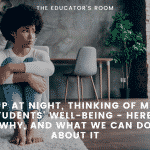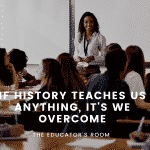Here we go again.
Many people are struggling with the new normal surrounding education and COVID-19. The kids have too much work. The teachers aren’t doing enough. It’s all busywork. Can you believe there are 5 live class meetings each week? Can you believe there is only 1 live meeting a week? How will students catch up? How will they cover everything at this pace?
For all those–myself included–working to figure out what education is, let the COVID-19 moment help. Yes, the identity of teaching was lost long before the arrival of COVID-19. First, it was having prep periods double as hall duty. Then, it was adding instructional time by limiting lunch and recess. Next came talk of teachers serving as security officers. Now, we are watching teachers and school systems reinvent themselves overnight. And, let it be clear: what you are witnessing is teaching.
[bctt tweet=”Teaching is a public service. ” username=””]
Teaching is a public service. That service is misunderstood. A teacher does not serve the public, now or ever, because they know about The Compromise of 1850 or how to conjugate a verb. Those districts and teachers harping on the necessity of worksheets and resources only serve to further the myth of the teacher as a provider of knowledge. Teachers provide stability, security, and space for students to grow in a chaotic, unpredictable landscape: childhood, adolescence, and beyond. The lessons that matter aren’t about content. Think about your favorite teacher. How many of those 180 daily lessons do you remember? Those teachers taught content, but, mainly, they set an example to follow; they served as an inspiration and image in which you could forge your own path.
For me, in 6th grade, I had Mr. Derfel. He was young, hip, cool, and had long hair. He taught us about the Civil Rights Movement. I learned who George Wallace and Bull Connor were for the first time, but past that, the content gets blurry. There was a lot going on in 6th grade: trying to be cool, interacting with girls, convincing my parents I was an adult. I remember my highlighter ran out of ink. Mr. Derfel had me reading a lot. I can’t remember a single thing I highlighted. There were a lot of discussions, and there was a presentation at the end of all the reading and conversations. That process of reading, studying, discussing, asking questions, and presenting stuck with me, and Mr. Derfel’s students’ first attitude too.
That Mr. Derfel’s lessons have endured for over 20 years is no surprise to educators. And, it is why educators are forging ahead now; they recognize that what we do is important well beyond today. This is a seminal moment in the lives of students. It is the perfect “teachable moment.” Disasters do not stop the process of, or need for, teaching. The process of becoming educated does not stop. It is ongoing. Forever. Therefore, teaching is about adapting and overcoming. The best educators aren’t necessarily the smartest ones but rather the ones most capable of highlighting a path to clarity in confusing times.
So, to those thinking and acting as though packets or video monologues are substitutes of any kind for the work teachers do in the classroom, you are undervaluing the worth and misrepresenting the value of teachers. Teachers introduce and help students build a pathway to success. Each content area thinks their pathway is unique, but, in reality, all learning follows a familiar arc of questioning combined with trial and error. Whether it’s trying to show youngsters how 2 and 2 equals 4, or it’s analyzing the hero arc in various forms of literature, the process is about figuring out what students know and helping them use that to solve some new problems. The process isn’t defined by a resource or lesson.
If you are at home, and you’re frustrated because the work doesn’t make sense, or it seems too hard, or it seems too easy, or you just don’t like it, this is what it is to be a teacher. Each student has a distinct set of needs and interests, and effectively teaching any student involves tapping into both. It’s ok to be irritated. It’s ok to be frustrated. It happens every day when teachers plan what they perceive as perfect lessons only to be bombarded by a dozen confusions all with different sources. Just remember, the lesson you are teaching in that moment isn’t about content; it’s about how to adapt and overcome. Eventually, the lesson gets internalized.







Thank you! Needed THAT. Hit a major block. I needed that to remember I belong here.
Thanks. At the end of this situation, the lessons our students will have learned will be about how adults around them were able to pivot with grace and resourcefulness or drown in a sea of victimization and blame.
That’s all wonderful in an ungraded world. How do you give anything less than 100 without feedback and expect the student to learn something? Whatever the approach, daily meetings, daily worksheets or a combination, there is no teaching being done if there is no feedback. So let’s be real, what some of us are witnessing is in fact NOT teaching.
I moderate a 2,965 member Middle School Science Teacher group on Facebook and am a National School Board Association award winner for Technology in the Classroom.
I just read your article and feel that we are not addressing the reality of today – we are missing the point. We need to stop referring to it as “Home Schooling”, “Distance Learning” and “Online Learning”, when it is really “Crisis Teaching”
Definition of crisis. 1a : the turning point for better or worse in an acute disease or fever. b : a paroxysmal attack of pain, distress, or disordered function. c : an emotionally significant event or radical change of status in a person’s life a midlife crisis.
The more real we are about the situation, the more real it is. There will be no “Return to normal” that is gone.Abandon the way you used to do things, that ship has already left.
Other forms of “Home Schooling” and “Distance Learning” are choices. This is NOT a choice. No teacher anticipated this. My wife was invited to go back into her classroom to gather personal items a week after the school closed.
We are not doing “Business as usual” but at home, we are trying to keep students in a positive learning environment – while in someone else’s care. We are in a “Crisis Teaching” mode. Please use those terms, otherwise it just means that teachers are lazy cowards – pushing their jobs onto children and parents that are already overwhelmed.
For me, I am retired and have taken my electronic lessons and re-purposed them for Crisis Teaching. I offer them for free during this time to use. I am re-purposing more of my materials for our children.
Teachers are doing amazing things – while trying to keep their own family alive. Honor what they are doing – Crisis Teaching.